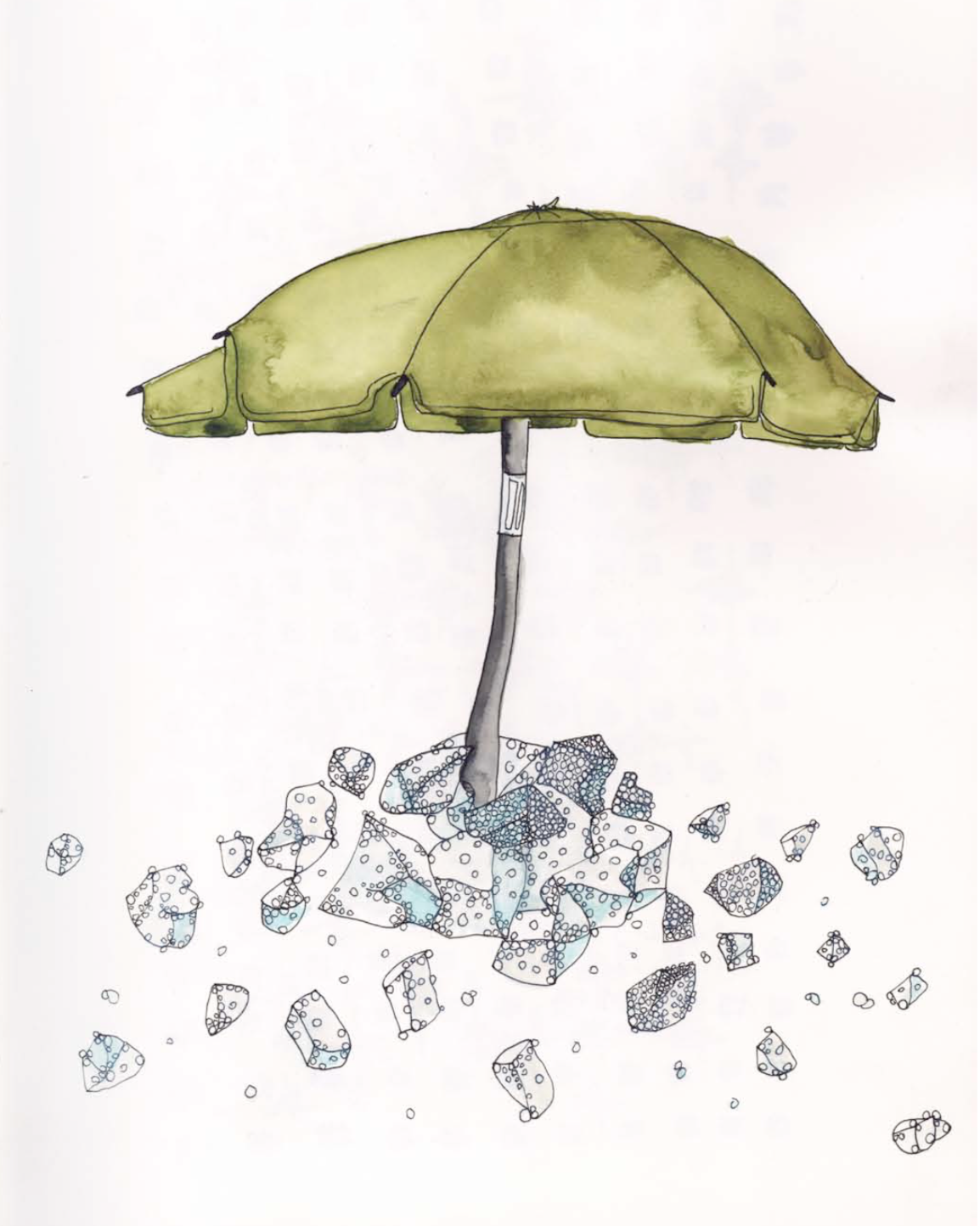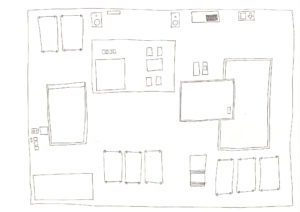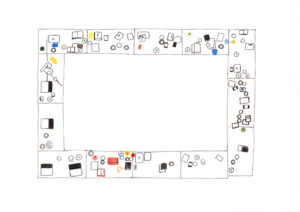Searching for a common ground: Social artistic practices and creative social work 4th – 6th July 2019, by Vera Leisibach and Gabriel Kuhn
In our documentation, the focus was on the in- cidental, insignificant or inconspicuous. We did not focus primarily on the content of the presen- tations or the content of the discussions, but on how the participants spoke, presented, gesticula- ted, how they moved, what tools they used and what dynamics arised in the conversations and in the small groups.
We documented subversive processes and de- tails that were central to the atmosphere through- out the workshop. These details were probably not perceived by the participants as part of the workshop, but they were subversively happening in the same place and were fundamental to the atmosphere and group dynamics that emerged in the workshop and during the breaks. Specifically, these details were the objects in the room, other people (passive or active in the same room), the light, the temperature, sounds, smells, colours and shapes that we noticed for some reason. Perhaps these subliminal, insignificant impressi- ons are even the things we remember the most after workshops like this one.
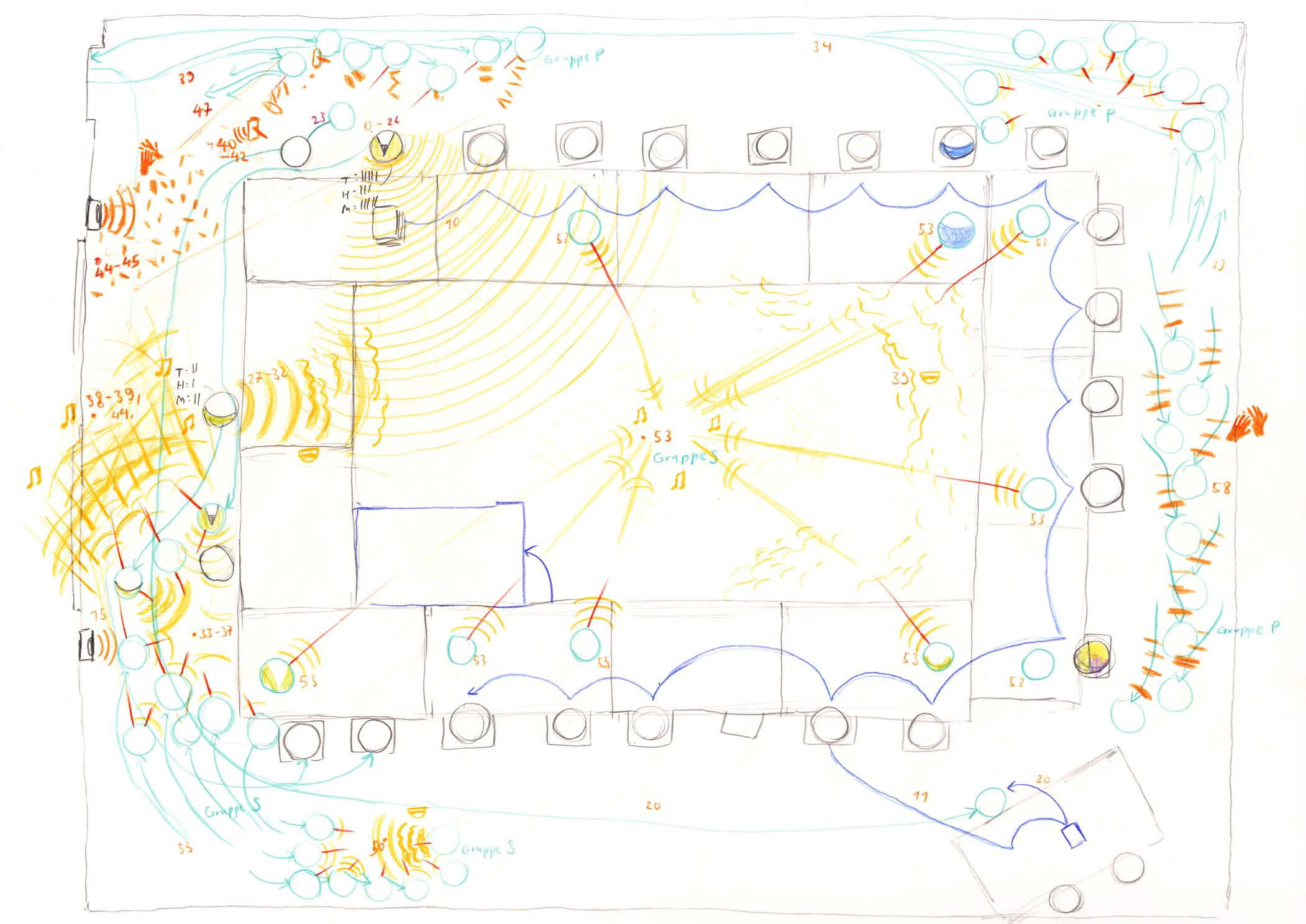
4th July 2019, 10:00 – 11:00 mapping / free statistics: Group Dynamics
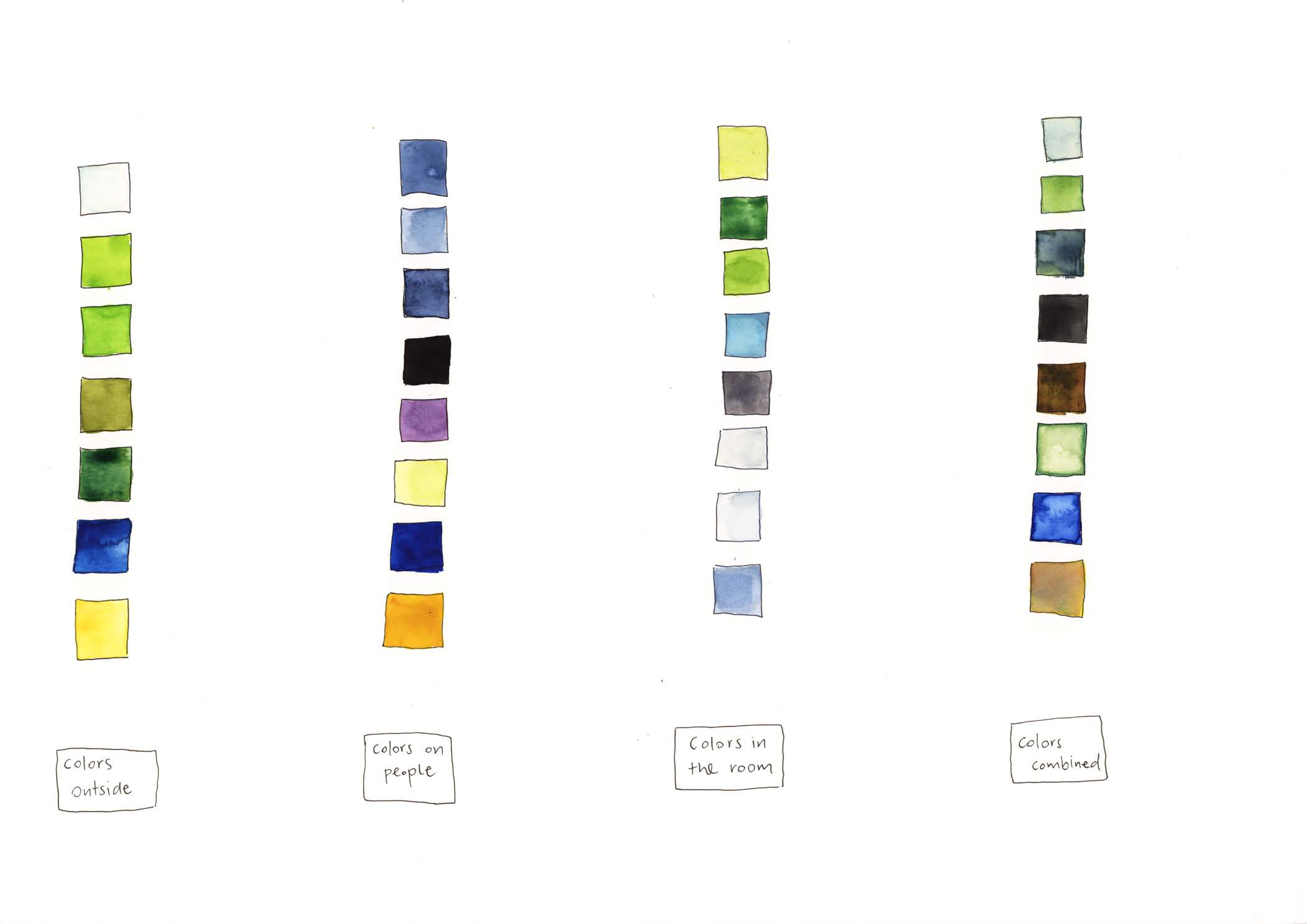
6th July 2019, 11:45 – 12:15 free statistics: Colour Stats
To capture these ephemeral aspects, such as the atmosphere and subversive dynamics, we deve- loped a strategy that allowed us to capture them in different techniques and on different levels.
Tools we brought:
Coloured pencils, pencils, sharpeners, fine liners, A3 sheets, sketchbooks/notebooks, photo ca- mera, watercolour box, acrylic paints …
How we proceeded:
We used one documentation technique per sessi- on and repeated the techniques regularly.
The techniques were:
1) Drawing / sketching with slogans 2) Mapping / charting / free statistics 3) Photography
For techniques 1 and 2 we worked on A3 sheets, on the excursion day in sketchbooks. After we fi- nished a picture, we exchanged our papers for input. In this way, we benefited from each other‘s observations. During the breaks, we also ex- changed experiences about the work process: what worked well for us and what not? These re- flections were also recorded in our logbook.

5th July 2019, 17:30 – 18:30 drawing/watercolour: Walser-Sculpture Styrofoam

5th July 2019, 17:30 – 18:45 drawing: Walser-Sculpture Scenery
Reflection
Our exchange was central to this project. We developed the concept of the artistic documen- tation together, influenced each other while do- cumenting and exchanged experiences over the three days. After the workshop was finished, we met again and talked about the project and wrote down a short reflection. Here we tried to summari- ze the most important points for us while working on this project. During the working process, we regularly looked at our drawings, mappings, char- tings, photos and free statistics. We discussed the experiences of observation, the production, and what these papers could mean for us and the workshop participants. It was an advantage that we always worked side by side, so we were inspired by the ideas of the other.
Working on A3 sheets was great on the one hand, because it left us a lot of space, but on the other hand we experienced a certain inhibition in front of the white sheet, since we initially had the fee- ling that we now had to deliver a „good picture“. Over time, however, we came to the conclusion that it could not be about delivering a finished, good picture, because the process, our experien- ces and observations were more important. We realized that this project is not about the individual pictures, but about the sum of all these pictures, that together give an impression of the workshop. During the presentation on the last workshop day, it became clear to us that our strategy of our arti- stic documentation seemed to be working for the participants of the workshop. Whether this would work for non-participants as well still needs to be tested. But presumably there is a need for a mediating element, because the project does not communicate itself.
Appendix: reflective dialog
Vera:
For the drawings, I noticed that I liked to set as many rules as possible in order to limit myself thematically. I always proceeded in such a way that I always set a theme for each drawing, mapping, charting, and free statistics. For example, I only drew haircuts, or just trin- kets, or mapped the fabrics in the room, or drew all backpacks. In order to follow my procedure, I needed to observe the room, as a first step. I needed to figure out what attracts my attention? How could I implement that?
Gabriel:
Our first limitation was set before the workshop star- ted, namley which session we would record as a map- ping and which as a drawing. The mapping is suitab- le for complex processes or as an inventory and was therefore a good choice, for instance, for the welcome address. This is because there were many movements and actions in the room which could be recorded using this technique. While for the mapping the focus needs to be set first, the drawing can be started more spon- taneously. However, it turned out to be better also for the drawing to record only one aspect (for example ge- stures, shoes or clothing colours) per image. By con- sistently observing one aspect, we discovered details that we probably would not have noticed otherwise.
Vera:
It was hard for me to focus on the content of the work- shop and at the same time on what I do on paper. You are focusing on such a different level, that what is spoken and shown on the projector, moves complete- ly into the background. The situation reminded me a lot of the arts and crafts classes in primary school, in which we listened to the tapes – the same ones over and over again – because we couldn’t really concen- trate on the contend while sewing at the same time.
Gabriel:
When I look at my pictures now, after the workshop, I involuntarily remember at some pictures who was speaking at that time or individual slides that were shown on the projector, although these things are not included in my pictures. In order to create such a link for other viewers, the picture needed to be combined with a written report of the workshop’s concent or with the slides shown during that session. For me the expe- rience of doing the drawing created a strong menory.
Vera:
On the second workshop day we were on the road and working in A4 sketchbooks. This was a different experience than working stationary at a desk. We were more flexible, we were able to move freely. This was a bit challenging at the beginning because we had to grasp a new environment before we could focus on
what we found exciting. So we were slower in the pro- cess, but the situations were more diverse.
Gabriel:
The outside spaces were more diverse than the mee- ting room at the art school, but also more difficult to grasp. In the neutral interior, the visual atmosphere was created to a bigger part by the participants themsel- ves. In the outdoor area, however, impressions such as smells, light-shadow situations or colours and shapes of the surroundings were added. The overlapping of workshop and environment was particularly appealing, for example laptops standing on a meadow with sun- light spots.
Vera:
In conclusion the procedure was incredibly productive for us. We had rules that we invented ourselves that gave us an orientation, but also allowed us to have enough freedom to let off steam in it.
Now that a week has passed since the workshop, what I remember best are the workshop participants, what kind of clothes they wore, what the different rooms looked like, how much light there was, and the different colour moods in them. I can also remember the individual items of clothing, and the objects that were in the room. I still have very clear pictures of these in my head. Colours, shapes, and details are still very present. This is because I was so focused on them. I looked at them, observed and thought about what I should take of them and how to put them in shapes, colors and mappings, or statistics. This process crea- ted strong memories for us. What I also remember are the conversations during the short breaks, while ea- ting, as well as the exchange with Gabriel. The questi- on, however, is, whether this documentation is a me- thod that works well only for the two of us, or whether it is the same for the workshop participants as well.
Gabriel:
Overall it was very important to me that we always in- fluenced each other when documenting. This resulted in more versatile results than if we had worked inde- pendently. Also looking at the pictures together and discussing them helped to develop and sharpen the further procedure. The trip to Biel has also given me new impulses. On the train ride I drew the silhouette of the passing hills, which led me to also apply this silhou- ette technique to the participants in the meeting room the next day. It would be interesting to find out whether the results would condense over a longer workshop or whether the ideas would become repetitive for time.
